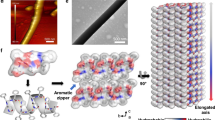Abstract
What musical notes can a molecule play? Carbyne is a chain of atoms that vibrates similar to an elastic string. Like the tuning of a guitar string, this vibration can be predicted based on length and tension. Using atomistic simulation, we determine the vibrational response of carbyne. We further produce audible notes, enabling specific musical composition with prescribed molecular conditions (pre-strain and length) and combine single chains into multi-chain systems to form molecular chords. Since the tension of a molecular chain is relatively low (<nN), such “strings” can potentially be developed for signaling and detection with high resolution.




Similar content being viewed by others
References
E.B. Wilson, P.C. Cross, J.C. Decius: Molecular vibrations: The theory of Infrared and Raman Vibrational Spectra. (Dover Publications, 1994).
H.N. Chapman, P. Fromme, A. Barty, T.A. White, R.A. Kirian, A. Aquila, M.S. Hunter, J. Schulz, D.P. DePonte, U. Weierstall, R.B. Doak, F.R.N.C. Maia, A.V. Martin, I. Schlichting, L. Lomb, N. Coppola, R.L. Shoeman, S.W. Epp, R. Hartmann, D. Rolles, A. Rudenko, L. Foucar, N. Kimmel, G. Weidenspointner, P. Holl, M.N. Liang, M. Barthelmess, C. Caleman, S. Boutet, M.J. Bogan, J. Krzywinski, C. Bostedt, S. Bajt, L. Gumprecht, B. Rudek, B. Erk, C. Schmidt, A. Homke, C. Reich, D. Pietschner, L. Struder, G. Hauser, H. Gorke, J. Ullrich, S. Herrmann, G. Schaller, F. Schopper, H. Soltau, K.U. Kuhnel, M. Messerschmidt, J.D. Bozek, S.P. Hau-Riege, M. Frank, C.Y. Hampton, R.G. Sierra, D. Starodub, G.J. Williams, J. Hajdu, N. Timneanu, M.M. Seibert, J. Andreasson, A. Rocker, O. Jonsson, M. Svenda, S. Stern, K. Nass, R. Andritschke, C.D. Schroter, F. Krasniqi, M. Bott, K.E. Schmidt, X.Y. Wang, I. Grotjohann, J.M. Holton, T.R.M. Barends, R. Neutze, S. Marchesini, R. Fromme, S. Schorb, D. Rupp, M. Adolph, T. Gorkhover, I. Andersson, H. Hirsemann, G. Potdevin, H. Graafsma, B. Nilsson, and J.C.H. Spence: Femtosecond X-ray protein nanocrystallography. Nature 470, 73 (2011).
C. Debus and P.H. Bolivar: Frequency selective surfaces for high sensitivity terahertz sensing. Appl. Phys. Lett. 91, 184102 (2007).
T.W. Crowe, T. Globus, D.L. Woolard, and J.L. Hesler: Terahertz sources and detectors and their application to biological sensing. Philos. Trans. R. Soc. A 362, 365 (2004).
M. Tonouchi: Cutting-edge terahertz technology. Nat. Photonics 1, 97 (2007).
B. Ferguson and X.C. Zhang: Materials for terahertz science and technology. Nat. Mater. 1, 26 (2002).
N. Chartuprayoon, M. Zhang, W. Bosze, Y.-H. Choa, and N.V. Myung: One-dimensional nanostructures based bio-detection. Biosens. Bioelectron. 63, 432 (2015).
K. Chenoweth, A.C.T. van Duin, and W.A. Goddard: ReaxFF reactive force field for molecular dynamics simulations of hydrocarbon oxidation. J. Phys. Chem. A 112, 1040 (2008).
M. Liu, V.I. Artyukhov, H. Lee, F. Xu, and B.I. Yakobson: Carbyne from first principles: chain of C atoms, a nanorod or a nanorope. ACS Nano 7, 10075 (2013).
A.K. Nair, S.W. Cranford, and M.J. Buehler: The minimal nanowire: mechanical properties of carbyne. Epl-Europhys. Lett. 95, 16002 (2011).
A.J. Kocsis, N.A.R. Yedama, and S.W. Cranford: Confinement and controlling the effective compressive stiffness of carbyne. Nanotechnology 25, 335709 (2014).
R.O. Jones and G. Seifert: Structure and bonding in carbon clusters C14 to C24: chains, rings, bowls, plates, and cages. Phys. Rev. Lett. 79, 443 (1997).
W.A. Chalifoux and R.R. Tykwinski: Synthesis of polyynes to model the sp-carbon allotrope carbyne. Nat. Chem. 2, 967 (2010).
C.H. Jin, H.P. Lan, L.M. Peng, K. Suenaga, and S. Iijima: Deriving carbon atomic chains from graphene. Phys. Rev. Lett. 102, 205501 (2009).
A. Chuvilin, J.C. Meyer, G. Algara-Siller, and U. Kaiser: From graphene constrictions to single carbon chains. New J. Phys. 11, 083019 (2009).
D.R. Grimes: String theory—the physics of string-bending and other electric guitar techniques. PLoS ONE 9, e102088 (2014).
A. Klapuri and M. Davy: Signal Processing Methods for Music Transcription (Springer, New York, 2006).
X. He, N. Fujimura, J.M. Lloyd, K.J. Erickson, A.A. Talin, Q. Zhang, W. Gao, Q. Jiang, Y. Kawano, R.H. Hauge, F. Léonard, and J. Kono: Carbon nanotube terahertz detector. Nano Lett. 14, 3953 (2014).
R. Chowdhury, S. Adhikari, and J. Mitchell: Vibrating carbon nanotube based bio-sensors. Physica E 42, 104 (2009).
S.W. Cranford, M.J. Buehler and SpringerLink (Online service): Biomateriomics, in R. Hull, C. Jagadish, R.M. Osgood, J. Parisi, Z. Wang, Springer Series in Materials Science (Springer, Netherlands: Imprint: Springer, Dordrecht, 2012), p. xvi.
S.W. Cranford: Thermal stability of idealized folded carbyne loops. Nanoscale Res. Lett. 8, 490 (2013).
W. Humphrey, A. Dalke, and K. Schulten: VMD: visual molecular dynamics. J. Mol. Graph. 14, 33 (1996).
Acknowledgments
A.J.K. and S.W.C. acknowledge generous support from NEU’s CEE Department. S.W.C. also wishes to thank James Hurley and Mark Belbin for fruitful musical discussion. The calculations and the analysis were carried out using a parallel LINUX cluster at NEU’s Laboratory for Nanotechnology In Civil Engineering (NICE).
Author information
Authors and Affiliations
Corresponding author
Electronic supplementary material
Supplementary materials
Supplementary materials
For supplementary material for this article, please visit http://dx.doi.org/10.1557/mrc.2015.9
Rights and permissions
About this article
Cite this article
Kocsis, A.J., Cranford, S.W. Composing molecular music with carbon. MRS Communications 5, 57–62 (2015). https://doi.org/10.1557/mrc.2015.9
Received:
Accepted:
Published:
Issue Date:
DOI: https://doi.org/10.1557/mrc.2015.9




